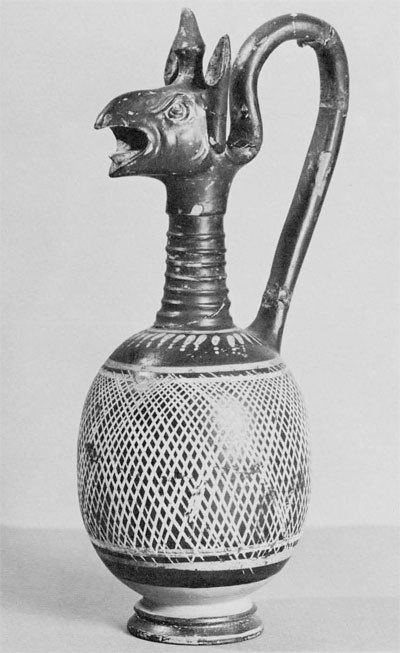
Egnatia lay on the Adriatic coast of southern Italy a few miles above Brundisium (Brindisi) and at the point where the direct route from Rome (later the Via Traiana) first met the eastern sea. Perhaps in early times it was an important seaport and a jumping-off place, later supplanted by Brindisi, for voyages across the narrow sea to Dyrrhachium (Durazzo) on the Illyrian coast opposite. In any case, the important Roman road which traversed the Balkan peninsula from the Adriatic to the Bosporos–the Via Egnatia–took its name from the small port on the Italian side.
The town has also given its name–though in a corrupted form–to a large class of South Italian pottery which has been found all over Apulia, and which was widely exported. Because vessels of this class were first found in tombs in the district of Egnatia, the fabric was dubbed “Gnathia Ware,” though the center of its manufacture was probably at Tarentum. Gnathia Ware flourished throughout the fourth and into the third century before Christ. It is characterized by carefully made vases, usually small, covered with a fine black varnish and decorated with painting over the varnish in white and yellow, sometimes also purple and red. Mostly the decoration is simple and geometric, embellished by garlands and leaves, often with clusters of grapes. The more elaborately painted specimens show birds, theatrical masks, or heads and busts of much-bejewelled ladies. Almost every important museum is liberally endowed with a collection of Gnathia vases, usually without pedigree because they were dug up by tomb robbers in the last century and sold to collectors.
The University Museum possesses its share, but one among these vases is outstanding. This is a jug (L-64-197, a part of the permanent exchange-loan from the Philadelphia Museum of Art) of which the upper part is modelled in the form of a griffin head. The lower part, decorated in white with simple latticing and with a row of jewels at the shoulder, should probably be dated (from its shape as well as its painted ornamentation) to the second half of the fourth century, about 350-300 B.C. The upper part, however, poses a problem. Gnathia vases of plastic form, modelled or moulded, are rare indeed, and a griffin is unique–by the mid-fourth century this beast had been dead for over two hundred years. A hybrid of oriental origin, part snake and part bird, the griffin enjoyed a period of great popularity in the Greek world of the seventh and early sixth centuries; then he disappeared.
Bronze was his proper medium, and many bronze busts (or protomes) of griffins once attached as ornaments at the shoulders of huge bronze cauldrons have come down to us. Such griffin cauldrons were worthy offerings for sanctuary or tomb, and many of the griffin attachments have been found at Delphi and Olympia where they were dedicated, as well as at Praeneste and Vetulonia in Etruria in tombs of the seventh century. The potters of this early period, like the later maker of our Gnathia jug, occasionally tried to imitate the form, but their brittle material was not suited to detail–to the great curving beak and protruding tongue, to the tall top-knot centered on the head, or to the high upward-pricked ears. Invariably the beaks were shortened and thickened for strength, the top-knots rounded, the ears reduced; the results were much watered-down versions of the fierce bronze originals.

Ulf Jantzen has made a study (Griechische Greifenkessel) of the bronze griffin protomes, dividing them into two classes on technical grounds, the hammered and the cast specimens, and into several sub-classes on stylistic grounds. He attributes their manufacture to two main centers, one in the Peloponnese, the other on the island of Samos. From the latter came most of the examples he lists, and their fabrication at Samos seems to be proved by the finding there of an example which was spoiled in the casting. The earliest bronze griffin must date from around 700 B.C., the latest from around 550. Over this period a development may be followed from the short-necked, stubby-eared type with high top-knot and inlaid eyes of the mid-sixth. The Museum possesses a bronze griffin protome of the later type bought by Dr. Hilprecht in Constantinople in 1907 (for twenty francs! 48-2-324), but it has been sadly mutilated, having lost its ears and top-knot and the end of its tongue. Three griffins found at Brolio in Italy better illustrate the type; together with three bronze ibexes they once adorned the same cauldron. It is this type, with alterations dictated by material and the jug form, which reappears on our Gnathia vase two centuries later. The alterations, which include the straightening of the neck, show that the jug was made by free modelling and not by casting in a mould taken from a bronze griffin. Nevertheless the fidelity to the original in style and in detail makes it certain that the potter had before him a proper bronze griffin of the first half of the sixth century while he was making his pottery jug in the second half of the fourth. If he was working at Tarentum, as seems likely, this is quite understandable, for Tarentum was the greatest center of art and industry in southern Italy of the time, noted for its woven goods as well as for its pottery, its terracottas, and its metalwork. Perhaps there, if anywhere, a sixth century griffin attachment could have survived as a studio piece to be admired, to be studied, even to be imitated by the artisans of a later day.
